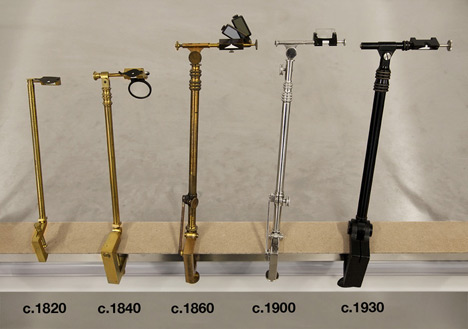 Looks cool...
Looks cool...
When I used to work for an artist who specialized in photorealistic portraiture, I remember watching the assistants use a projector to draft the preliminary pencilwork for his medium-to-large scale (30”×40”+) paintings. Since we were working with digital compositions, it was a simple matter of lining up the image with the canvas or archival paper, then painstakingly tracing the photograph and background onto it.

Now that software has democratized and simplified the tools of creating images, I imagine this is a common practice in artists' studios. But what about drawing from real life? Most everyone has seen or at least heard of camera obscura, but it turns out there's a somewhat more, um, obscure tool that draftsmen of yore had at their disposal.

Pablo Garcia and Golan Levin (Art Professors at SAIC and CMU, respectively) note that "long before Google Glass... there was the Camera Lucida." The device is a "prism on a stick," a portable lens-like device that is affixed to a drawing surface, allowing the user to accurately reproduce an image before them by hand.
We have designed the NeoLucida: the first portable camera lucida to be manufactured in nearly a century—and the lowest-cost commercial camera lucida ever designed. We want to make this remarkable device widely available to students, artists, architects, and anyone who loves to draw from life. But to be clear: our NeoLucida is not just a product, but a provocation. In manufacturing a camera lucida for the 21st century, our aim is to stimulate interest in media archaeology—the tightly interconnected history of visual culture and imaging technologies.

According to the well-illustrated history page on the Neolucida website, the device was invented by Sir William Hyde Wollaston in 1807, though the Wikipedia article suggests that it was actually developed by Johannes Kepler, whose dioptrice dates back to 1611, nearly two centuries prior.
 Selections from Pablo Garcia's personal collection of vintage camera lucidas
Selections from Pablo Garcia's personal collection of vintage camera lucidas
























 Woven vessels by F Taylor Colantonio
Woven vessels by F Taylor Colantonio Bent-wood room divider by Elish Warlop
Bent-wood room divider by Elish Warlop Plastic Persian carpet by F Taylor Colantonio
Plastic Persian carpet by F Taylor Colantonio F Taylor Colantonio
F Taylor Colantonio Patterns on patterns on patterns by F Taylor Colantonio
Patterns on patterns on patterns by F Taylor Colantonio The Beer Bag, by Marco Gallegos
The Beer Bag, by Marco Gallegos The Lilu Table, by Marco Gallegos
The Lilu Table, by Marco Gallegos The Graduate Furniture class, photo by Anelise Schroeder
The Graduate Furniture class, photo by Anelise Schroeder



















 I was tempted to photobomb this image with Blown Away Guy...
I was tempted to photobomb this image with Blown Away Guy...






 Image by Carola Merello; via
Image by Carola Merello; via  Via
Via 












 Andrew Cheng - Copper Chair
Andrew Cheng - Copper Chair Candice Lin - Loungi
Candice Lin - Loungi Nuri Kim - Nu Serveware
Nuri Kim - Nu Serveware
 Andrew Cheng - Nylon Chairs
Andrew Cheng - Nylon Chairs Scott Ross - Axiom Knife
Scott Ross - Axiom Knife





 Founder John Randall noted that "Water Tower" was made of reclaimed wood from the very same; it's intended to hold a standard five-gallon water bottle, as an alternative to the mundane water cooler.
Founder John Randall noted that "Water Tower" was made of reclaimed wood from the very same; it's intended to hold a standard five-gallon water bottle, as an alternative to the mundane water cooler. What's that around the corner...?
What's that around the corner...?














